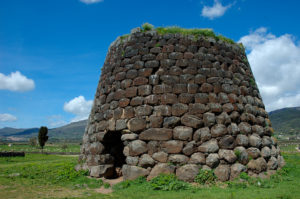Sisera’s Island Invites the Jews Back

In a moving ceremony, the mayor of the Italian town of Alghero on the island of Sardinia issued an apology to the Jews banished from the place in 1492. At the time, Sardinia was under Spanish rule and the Spanish regime was either expelling Jews, forcing them to convert to Christianity, or burning them at the stake as heretics. So in 1492, Sardinia became emptied of Jews. Of course, there were some “conversos” i.e., people forced into conversion, who continued to live on the island in constant fear of the Inquisition.
The irony is that by 1492, Jews had been living on the island for at least 1,500 years and may have had contact with the island since the 13th century BCE. Meaning, there may have been a Jewish presence on Sardinia for 2,800 years before the Spaniards decided that enough was enough.
According to Professor Adam Zertal of Haifa University, the site of el-Ahwat, 7.5 acre city near Nahal ‘Iron in northern Israel, was a Sardinian outpost in the 13th century BCE.

Zertal compares the site’s “undulating” wall, corridors, tholoi (a bee-hive shaped tomb), inner dividing walls, and free-standing corbeled stone “huts” to the nuraghe (bee-hive like towers) of Bronze Age Sardinia. He then identifies the “fortress” at el-Ahwat with the Biblical site of “Harosheth Haggoyim”. Judges 4:2-3 of the Hebrew Bible describes a war between the Israelite General Barak and the Canaanite General Sisera. Barak has the prophetess Deborah in his camp. The other woman that plays a key role in this story is Yael, Heber’s wife, who promises the fleeing Sisera a safe hiding place, only to seduce him and kill him. Zertal believes that Sisera is a Sardinian and that el-Ahwat in Israel was his stronghold. In other words, the Jewish contact with Sardinia may have already taken place 3,300 years ago as mentioned in the Book of Judges.
Whatever the merit of Zertal’s theory, we know for a fact, from 1st century Jewish historian Josephus, that 4,000 Roman Jews were exiled to Sardinia in 19 CE during the reign of the Emperor Tiberius. There were Jewish communities in Oristano, Lula, Gallura, Nora, Sinai (clearly founded by Jews), Canahim (i.e., zealots in Hebrew), Sulcis, Tharros, Alghero, Colmedia, and Cagliari. There are even Jewish catacombs in Sardinia. When the Roman Empire went Christian, things got bad for the Jews. In 1325 CE, Sardinia fell under the rule of the Spanish kingdom of Aragon. Within 175 years, the Jews were all gone.
Now, miraculously, the mayor of Alghero – formerly the largest Jewish community – closes a circle and invites the Jews back. Instead of banishing Jews, he wants to celebrate their presence on the island. No doubt many native Sardinians have a long forgotten Jewish past. Perhaps given the new atmosphere, some Sardinians may even find their way back to their people. Whatever happens going forward – as in the Book of Judges – it’s clear that the Jewish people did better against the Siseras of the world when they fought them on their own territory. So I doubt that the Jewish people will be taking up the good mayor’s invitation anytime soon. Been there, done that. But it’s nice to be invited and it’s time that the ancient links be reestablished.
Click here to see my recent article “Happy Birthday Cervantes” on The Times of Israel

